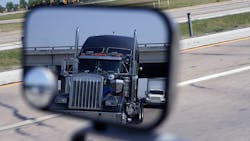Federal regulators are formalizing requirements for automatic emergency braking systems for medium- and heavy-duty vehicles, which the National Highway Traffic Safety Administration said could save more than 150 lives and prevent nearly 20,000 crashes yearly.
The U.S. Department of Transportation and Federal Motor Carrier Safety Administration announced a notice of proposed rulemaking Thursday requiring new vehicles with a gross vehicle weight greater than 10,000 lb. to be equipped with AEB systems to reduce the frequency and severity of rear-end collisions.
The proposed rule, expected to become final next year, would apply to all newly built Class 3 through Class 8 vehicles. If approved on that timeline, Class 7 and Class 8 vehicles must have AEB systems by model year 2027. New medium-duty vehicles would require the technology by model year 2028. A similar rule for light-duty trucks and cars was previously proposed. Both are part of the 2021 Infrastructure and Investments Jobs Act initiatives.
See also: Safety tech's immense value
"Advanced driver assistance systems like AEB have the power to save lives," Ann Carlson, NHTSA chief counsel, said during a June 22 news conference. "Today's announcement is an important step forward in improving safety on our nation's roadways by reducing, and ultimately eliminating, preventable tragedies that harm Americans."
How AEB systems work
AEB systems use a variety of sensors to detect when a vehicle is in a potential collision. If the driver does not react in time, the system will automatically apply the brakes. In some cases, the system may also apply additional braking force to supplement the driver's braking. The proposed standard would require AEB systems to work at 6 to 50 mph.
"This technology can enhance the effectiveness of commercial motor vehicle crash reduction strategies and reduce roadway fatalities," FMCSA Administrator Robin Hutcheson said Thursday. She noted that the AEB standards are part of the DOT's National Roadway Safety Strategy, an initiative she worked on as a deputy transportation secretary before taking over FMCSA in 2022.
About 60,000 rear-end crashes involving large trucks and buses occur annually on U.S. highways, according to NHTSA statistics. The safety agency estimates the proposed rule would prevent 19,118 crashes, save 155 lives, and prevent 8,814 injuries annually. In a 2022 study, NHTSA found that vehicles equipped with AEB and forward-collision warning technologies cut crash frequency in half.
American Trucking Associations has been pushing for AEB technology on all new vehicles for years, urging manufacturers to make it standard on all vehicles since 2015. "With NHTSA's recent regulation requiring AEB on all new passenger vehicles, this proposal for heavy-duty trucks is timely and appropriate," Dan Horvath, ATA VP of safety policy, said.
"The trucking industry supports the use of proven safety technology like automatic emergency braking," Horvath added. "We look forward to reviewing this proposal from NHTSA and FMCSA and working with them as it is implemented."
NHTSA and FMCSA officials noted they used feedback from the safety advocacy community, industry representatives, and others to create the proposed rule.
"Humans are fallible. Sometimes truck drivers are distracted or fatigued," noted Zach Cahalan, executive director of the Truck Safety Coalition. "AEB is effective even when humans make mistakes. This is a slam dunk for roadway safety."
Public comments on the proposed rule can be submitted for 60 days once the proposed rule is filed in the Federal Register.
About the Author
Josh Fisher
Editor-in-Chief
Editor-in-Chief Josh Fisher has been with FleetOwner since 2017. He covers everything from modern fleet management to operational efficiency, artificial intelligence, autonomous trucking, alternative fuels and powertrains, regulations, and emerging transportation technology. Based in Maryland, he writes the Lane Shift Ahead column about the changing North American transportation landscape.

